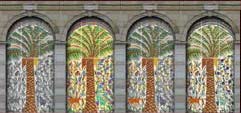|
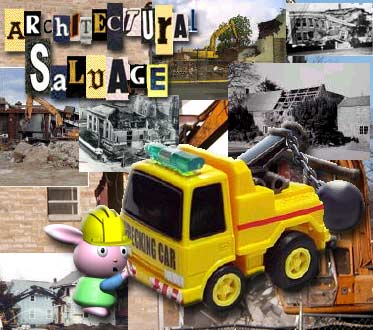
|
|
This
page is intended to help inspire interest in preserving
our ever-dwindling architectural heritage & to foster
a growing
consciousness so we can:
-
Become
more aware of our built heritage;
-
Encourage
good preservation practices;
-
Lobby
for a high standard of conservation where necessary;
-
Look
for ways to enhance the architectural qualities of our
surroundings;
-
Guard
against unnecessary loss of irreplaceable items.
Traditional
building materials and architectural period features are
becoming increasingly difficult to obtain and expensive
to buy, creating problems for remedial, repair or new period-style
building work. Yet, astonishingly, many traditional materials
and features which could easily be reused - some of historic
or architectural importance - are instead destroyed because
no immediate use is apparent - or as is often the case,
no immediate buyer is found.
|
|
|
Over
my months of tmoggery, I have accumulated various items that were
going to be part of themes or sets, but never got round to doing
any more in that particular style, and just put them in a folder
to gather dust. In keeping with my philosophy of conservation,
I now offer them to you as freestanding items to be used in whatever
particular situation you feel appropriate. I still like to make
some oddments now and again, and you will find those here as well.
Some of these I may still develop into larger themes, in which
case I will move them accordingly - and mark them once moved so
you do not download them twice.
|
| The
greatest folly of these modern "enlightened"
times was the recent loss
of the famous Wembley Stadium towers in London (pictured
right) to make way for an ultra-modern football stadium.
Do not get me wrong - I am not against progress and
actually adore many of the new trends in architecture
including the proposed
stadium, but I remain convinced that there could
also have been a way to incorporate such powerful and
beautiful icons into the new design were the true desire
there. |
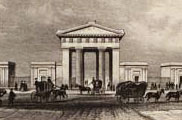 |
Instead,
after months of wrangling and lip-service to their
glory, they have joined the Euston Arch (pictured
left) & other long-lost London landmark treasures
reduced to rubble & anonymous landfill. Such
a sad, ignominious end to structures originally
heralding all that is progressive and a future
so bright. |
|
|
 |
| To
find out more about this tragic event in UK architectural
history, there are some excellent articles with links here
and here
(if you can stand the large coloured print, this second one
is a passionate & excellent essay) and also here. |
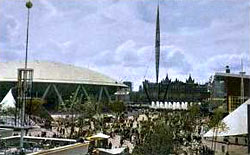 |
I
personally do not agree with most opinions on the Millennium
Dome (pictured right). I realise I am in a small minority
here for being such a fan of this structure, but that is another
modern landmark I find fascinating and perhaps, like the UK
1951 Festival of Britain Dome and Skylon (family postcard
pictured left) or the wholescale demolition of the US roadside
diner / "googie" architectural style, it will only
truly be appreciated once it has gone. |
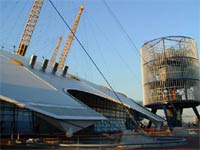 |
|
|
 |
| Miscellaneous
items & sets made from......brick! |
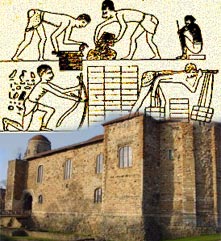 |
|
|
The
story of brick reaches back into pre-history. There is evidence
of bricks and brickmaking in ancient India, the Middle East,
North Africa, and North and Central America. The first sun-dried
bricks were formed in around 8,000 BC in Mesopotamia - now
Iraq. However, it was not until bricks were fired in a kiln
that they became truly durable. Excavations have found perfectly
preserved fired bricks dating from as far back as 5000 BC.
The
material employed in the earliest buildings constructed
around Rome was "tuff", a volcanic rock of varying
hardnesses, some soft enough to be worked with bronze tools.
Later, other harder volcanic stones were used, such as peperino
and albani stone from the nearby Alban hills. The Romans
developed the manufacture of bricks and took their technology
into conquered lands, including Britain in 54 BC.
Although
the skill was lost when the Romans finally withdrew in 410
AD, Roman bricks were recycled over the centuries, a prominent
example being Colchester Castle (pictured right), completed
in 1080 AD from bricks then over a millennium old. The English
brick industry was revived by Flemish brickmakers brought
to England in the thirteenth century.
For
centuries all aspects of brickmaking were done by hand,
from extracting clay to shaping bricks and setting and drawing
the kiln. It was common in remote areas for clay to be extracted
and bricks shaped and fired on the site by itinerant brickmakers.
Until the early 1800s bricks were fired in clamp kilns that
were pulled down to remove the bricks. These were slowly
replaced by permanent kilns. A big change came in the mid-1800s
when steam power mechanised the arduous task of hand moulding
bricks. A handmoulder turning out 1000 to 1300 bricks a
day was no match for a machine producing 15,000 bricks a
day.
|
|
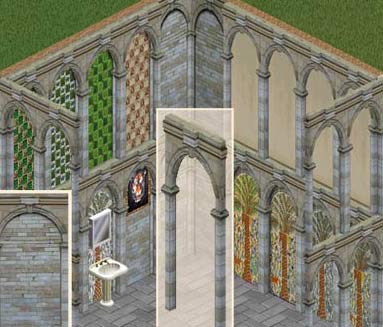 |
 Standalone
arch & tiled walls & floors
Standalone
arch & tiled walls & floors
The
arch is backless and droppable with thanks to Koromo at Persimmon
Grove, without whom I simply would not have anything unique to
add to this site.
The
arch can be used anywhere you like! Based on a droppable rug piece,
your sims can walk over them, you can put other items on the same
tile and HD users can place wall mountable items on the windows
as well. They won't generate a roof when used on a second floor,
so are good for creating an open colonnade walkway.
To
use on a second floor you will need to place them on the transparent
floor tile from Caro's
Sim Kagen.
I
do not recommend placing them in inside corners as there will
be some bleedthrough while the walls are up.
|
| I
have renamed & included the walls & floors from the
old "Moorish Style" & "Tiled Mural Arch"
sets which you may already have, and the plain version is
included with the "More Old Bricks" set on the Urban
Textural Archive page. |
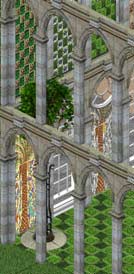 |
The
brick arch image is taken from a photograph I took
of one of the platform walls at Edinburgh's majestic
Waverley Railway Station while waiting for my train
some time in 1993.
That
was a memorable journey - it took longer to travel
the 400 miles to my home by train than it took us
to fly to New York a month later - including all
the hanging around at check in & waiting at
Heathrow.
|
|
|
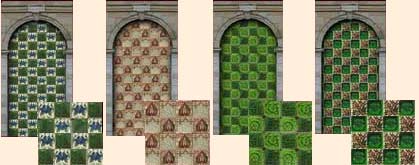 |
|
Waverley
Station is in the centre of Edinburgh. It is a vast construction
with over 20 platforms, set deep in the valley between the
old and new towns of Edinburgh in the shadows of both Edinburgh
Castle & the monument to Sir Walter Scott.
|
|
|
|
|
During
the 1850s and 1860s, British archaeological and historical study
of the East was flourishing, and saw a great enthusiasm for decorative
styles generically known as "Moorish". It was fundamentally
a picturesque style, largely used in the field of interior design
mostly thanks to a pattern book unequalled before that time: Owen
Jones' Grammar of Ornament, published in 1856.
I
go into more detail about this wonderful book in the Urban Textural
Archive page, and intend to do a full recolour furniture set one
day based on these stunningly detailed and rich patterns. Owen
Jones analyzed ornamental styles ranging from those of primitive
tribes to the Renaissance, and in each chapter he consolidated
a wealth of patterns from documented sources which he reproduced
in multi-coloured lithographs, thereby making the Grammar of Ornament
a crucial sourcebook of design motifs for craftsmen and commercial
designers alike. Although an excellent book of permission-free
reproductions is available through Dover Publications (of whom
I am a great fan & have this and many more of their titles),
if any of my readers have an original copy tucked away gathering
dust in their attic they don't want anymore, please let me know!
|
|
 |
| Miscellaneous
items & sets made from......metal! |
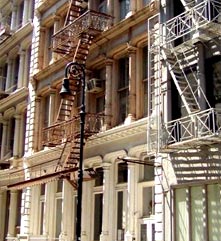 |
|
|
Metal
has been used in building in various forms for many centuries.
More often than not, it was used for window framing, but
sometimes inside a double-walled structure to give extra
strength, or for roofing.
Decorative
cast
iron frames were a mass produced American architectural
innovation of the 19th century. Used as building facades,
cast iron was cheaper than stone or brick and allowed ornate
features to be prefabricated from moulds in foundries. This
was an inexpensive way to produce a structure with a face
that was ornate, costly looking and stylish, which at first
meant classically inspired Italian Renaissance, and later,
French architectural styles.
The
new facades permitted designers to build larger windows
on all floors, bringing natural light to where there was
none. Today,
New York City has the world's largest concentration of full
and partial cast iron facades. The best, built in the 1870s,
are in the SoHo Cast-Iron District (pictured right).
In
England, an efficient, prefabricated method of internal
skeletal construction was developed, of which the most notable
example was Joseph Paxton’s Crystal Palace (1851) in
London. Iron and glass canopies were used to cover such
diverse structures as shopping arcades, library reading
rooms, and the vast new railway terminals.
Today,
metal is used far more in architecture than just the traditional
roofing and facades of industrial sheds. It is greatly used
for its aesthetic qualities to cover theatres, museums,
and exhibition buildings with shimmering layers of copper
and titanium. It enables extravagant forms to be constructed,
and even in low-cost, prefabricated buildings, metal is
used in new and interesting ways.
|
|
|

Staircase,
boundary fence and ivy-covered fence to match the Unleashed iron
arch and balcony fence.
|
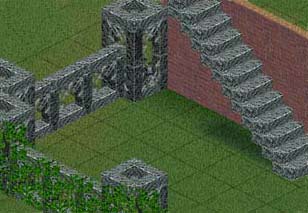
|
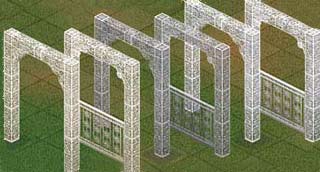 |

Cream,
grey & white Unleashed arches & matching fence
|
|
 |
| Miscellaneous
items & sets made from......glass! |
 |
|
|
Natural
glass is formed when certain types of rocks melt in the high
temperatures of volcanic eruptions or lightning strikes, and
then cool and solidify rapidly. Stone-age man is believed
to have used cutting tools made of obsidian - a natural glass
of volcanic origin.
The
Roman historian Pliny attributed the discovery of glass to
Phoenician sailors in around 3000 BC who landed on a beach,
propped a cooking pot on some blocks of nitrate (an alkali
soda) and made a fire over which to cook a meal. To their
apparent surprise, the sand beneath the fire melted and ran
in a liquid stream that later cooled and hardened into glass.
The
earliest man-made glass objects, mainly Egyptian non-transparent
glass beads, are thought to date back to around 2500 BC. Modern
glass originated in Alexandria during the Ptolemaic period,
where artisans created "mosaic glass" in which slices
of colored glass were used to create decorative patterns.
The first glassmaking "manual" is a series of tablets
from the library of the Assyrian king Ashurbanipal (669-626
BC).
Glassblowing
was invented during the 1st century BC in Syria. It was the
Romans who began to use glass for architectural purposes around
AD 100. Semi-opaque cast glass windows began to appear in
the most important buildings in Rome and the most luxurious
villas of Herculaneum and Pompeii. During the 15th century
in Venice, the first clear glass - called cristallo - was
invented and then heavily exported. In 1675, glassmaker George
Ravenscroft invented lead crystal glass by adding lead oxide
to Venetian glass.
In
1902, Irving W Colburn patented the sheet glass drawing machine,
making the mass production of glass for windows possible.
Safety
glass was invented in 1903 as the result of a mistake by Edouard
Benedictus, a French scientist, who after knocking a glass
flask to the floor found the broken pieces hanging together
in their original shape. The flask had contained cellulose
nitrate, a liquid plastic, which had evaporated leaving a
thin coating of plastic on the interior. In 1904, a patent
for a "glass shaping machine" was granted to a Michael
Owen, leading to the mass production of glass bottles &
jars.
|
|
|
|
Some time ago
at one of the object making forums at N99, a few of us online at
the time were pointed to a story called Sim Alicubi (on a site called
Alicubi)
- and specifically told to look at the windows in the story. Our
reaction went something like this: WOW.
On further investigation
with Alicubi, the windows (pictured left) were revealed to be clever
mock ups just for the story and not real objects - but don't they
look good! So a
couple of us decided to try their hands at making some similar high-rise
office block windows.
I wanted to
use a window where it looked normal from the outside of the house,
so for the following sets, I chose the large corporate window -
how appropriate for an office setting!
|
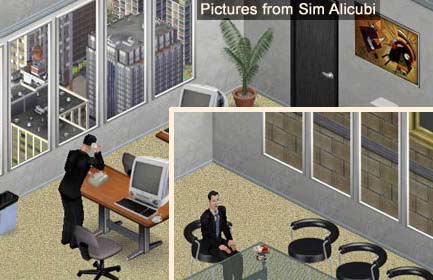 |
|
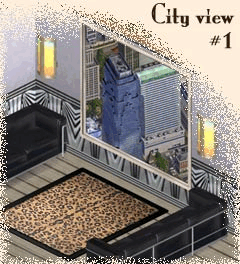 |
 Cityscape Tower Block View windows
Cityscape Tower Block View windows
REPAIRED 2015, Please Redownload
The
original Tower Block view window I did needed a bit of improving,
so here it is again with three other companions, ideal for your
downtown penthouse apartment or office block.
Like
all my "windows with a view" they only have a view from
the inside and are normal from the outside.
Bauhaus sofa
pictured from 7DS, other objects, walls & floors default from
game.
|
 |
|
 Hollywood View windows
Hollywood View windows
This
set features a panoramic view of the famous Hollywood sign
- perfect for your starlet sims! The views are on one side
only, so from the outside of your house they look normal -
but on the inside, hey presto! A room with a view.
|
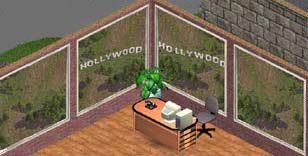 |
|
| This
is a pack of three one-way windows - one each of the Hollywood sign
for right facing and left facing walls, and one Hollywood Hills landscape,
all normal from the outside. |
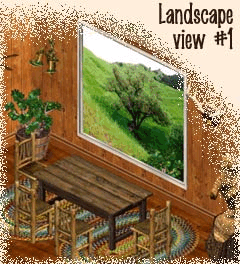 |
 Landscape View windows
Landscape View windows
Three
large windows with panoramic landscape views, which like
all my "windows with a view" only have a view from the
inside and are normal from the outside.
|
|
 |
| Miscellaneous
items & sets made from......fabric! |
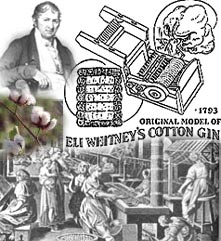 |
|
|
It
is thought that people began to weave fabric made from flax
during the Neolithic Era, a period that began around 8000
BC. The earliest use of cotton fabric is estimated between
3,000 BC to 5,000 BC, but certainly worn by Egyptians earlier
than 2,500 BC. However, it was not until Eli Whitney's invention
of the cotton gin in 1793 that the processing of cotton became
easier and quicker. The development of the power loom in 1884
brought significant improvements and variations to cotton
fabrics.
Wool
had widespread use throughout the world from around 3000 BC,
but for centuries, the silk-wearing Chinese despised it, considering
it the fabric of uncivilized people. China kept the technology
of silk production secret; so much so that the ancient Greeks
speculated that silk grew on special Chinese trees. It is
believed to have been discovered by a Chinese princess, and
is made from two continuous filaments glued together to form
the cocoon of the silkworm.
The
first patent for “artificial silk” was granted in
England in 1855 to a Swiss chemist named Audemars. The first
commercial production of a manufactured fibre was achieved
by French chemist Count Hilaire de Chardonnet. In 1889, his
fabrics caused a sensation at the Paris Exhibition. Several
attempts to produce artificial fibres in the United States
were made during the early 1900's but none were commercially
successful until the American Viscose Company, formed by Samuel
Courtaulds and Co., Ltd., began its production of rayon in
1910. This was followed in 1939 by nylon from the DuPont Company,
then various companies introduced acrylic in 1950, polyester
in 1953, spandex in 1959 & microfibre in 1989.
|
|
|
Lace
curtains for all! 
These are recolours with grateful permission of one of STP Carly's
"Lace Curtains for All" because the pattern was so beautiful
and it just needed to be seen in different colours :o)
These curtains are backless & act as lights. Why did Carly do
it this way? In her own words: "Because these curtains files
were just too large as Unleashed clones, over 1 mb for each. This
way I save space & bandwidth & everyone gets to enjoy them!"
|
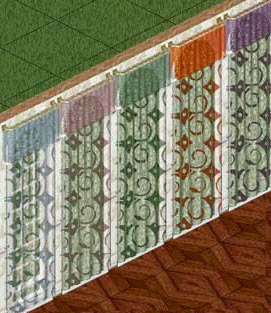
|
|
|
|
|
The zips on these
page may contain a number of different items. Unzip to a temporary storage
folder, and you must move the files accordingly as below:
- Files ending
in .wll
to C:\Program Files\Maxis\The Sims\GameData\Walls
- Files ending
in .flr
to C:\Program Files\Maxis\The Sims\GameData\Floors
- Files
ending in .bmp to C:\Program Files\Maxis\The Sims\GameData\Roofs
- Files ending
in .iff to C:\Program Files\Maxis\The Sims\GameData\UserObjects
If you would like
to redesign or recolor objects from Architectural Salvage, please provide
credit on your site and in the object description with a link back to
us. Most recolours here are from base items from sites participating in
the Recolourers Resource Project, but where I have had specific permission
for an item to be cloned for this set, you will need to ask the same permissions
from the original designer - these are as follows:
- Lace Curtains for
All - please contact Carly at the Sims
Tattoo Parlour
All links to the original
site where I have made the recolour from are given. See notes on home
page.
|
|














